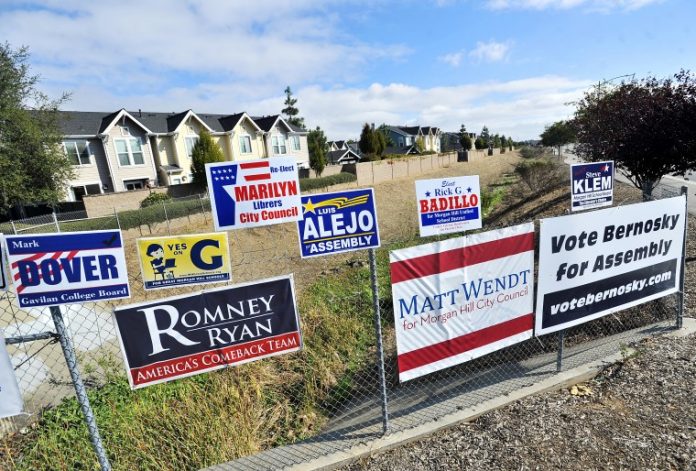
Dozens of local, statewide and district candidates set to appear on the Nov. 6 presidential election ballot have turned Morgan Hill’s chainlink fences, high-profile intersections and publicly owned yards into collages of colorful political signs in recent weeks.
The bad news about that is that most – if not all – of the political signs erected on public property were placed there illegally. The good news is the city isn’t likely to enforce the aesthetic assault on these high-visibility areas because violations are rampant, according to city staff.
The city’s lengthy sign ordinance regulates the posting of every kind of directional, commercial, temporary, memorial and informational sign (and even Christmas decorations) that one might seek to post in the city limits, at any time of year. Many of these signs require permits from the community development department, whether they are placed on private or public property.
However, temporary political signs are specifically exempt from that requirement, as long as they are placed on private property. Political signs are not allowed on public property that is owned by the city or another public agency, unless the sign owner acquires an “encroachment permit” to install them, according to city staff.
A popular public area where candidates and supporters of various measures and propositions have posted their signs is along Butterfield Boulevard, on chainlink fences at the intersections of Central, Main, Diana, Dunne and Tennant avenues.
These fences surround the openings to the Butterfield stormwater and flood channel, which runs parallel to the road on its east side. The fences have transformed into unofficial bulletin boards announcing your political options come Nov. 6, which is illegal unless the candidates acquired an encroachment permit.
“There are lots of signs in Morgan Hill – both commercial and political,” city manager Ed Tewes said. “Many of the signs are placed in illegal locations.”
However, the city doesn’t have the resources to enforce the ordinance and remove all of the illegal signs, except in the “most egregious” situations where the placards present an eyesore or visibility danger to pedestrians or motorists, Tewes said.
When local candidates filed their papers to run for office, they were given a packet of paperwork informing them of various guidelines and schedules relating to the electoral process. This information included rules on sign placement in the city limits.
“We signed something saying we know the policy, and we will follow the policy,” said Councilman Larry Carr, who is running to retain his seat on the council.
Carr – the only council candidate whose signs were absent from the Butterfield channel fences as of Wednesday – said he deliberately restricts his campaign sign placement to private properties whose owners have given him permission to do so.
“If an overzealous volunteer has placed a sign somewhere it’s not allowed, I very promptly take them down,” Carr said, referring to his own signs.
Morgan Hill police Sgt. Troy Hoefling noted that some campaigns might have “so many people assisting” that the volunteers might not know all the rules.
The city’s police department employs a part-time graffiti abatement officer whose responsibilities include removing illegal signs that pose an eyesore or possible hazard, Hoefling added.
City staff did not know how many political signs have been removed this campaign season due to their offensive appearance or potential hazard.







